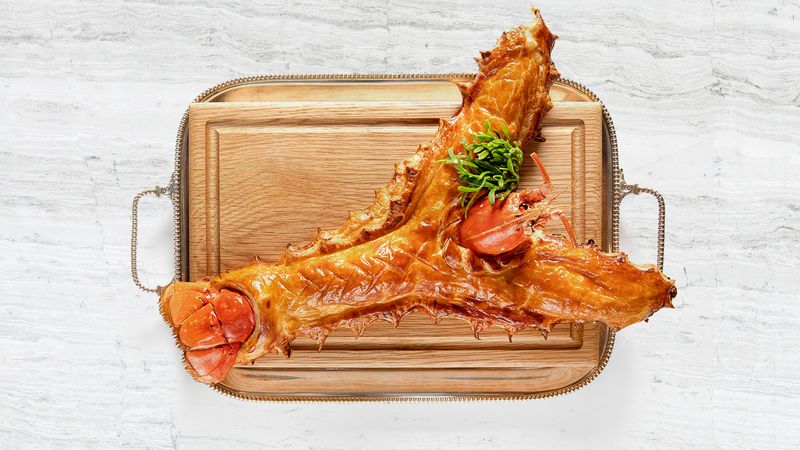THE JOURNAL

Lobster Wellington at Claridge’s. Photograph courtesy of Maybourne Hotel Group.
No matter what’s going on outside – and having been open for more than a century, this place has seen a thing or two – step through the revolving doors of Claridge’s onto the chequerboard marble floor, and all’s right with the world. The five-star Mayfair hotel is a British institution. Its glimmering Art Deco interiors and impeccable service (the staff’s motto is that nothing is too much trouble – including flying in a guest’s favourite cookies from New York) have attracted Hollywood film stars, royalty and the fashion elite.
The kitchen here turns out 1,000 covers a day, and executive chef Mr Martyn Nail is the man in charge. The menu at The Foyer restaurant, a low-lit space decked out with crystal chandeliers and velvet banquettes, spans comfort-food classics, such as chicken pie and beef tartare, as well as modern dishes – crab and coriander maki, or seared Portland scallops with grapefruit and radicchio. “It’s important that we introduce guests to new things, and Instagram means different food is more accessible than ever,” says Mr Nail, who oversees a team of 65 chefs. “Claridge’s is not a museum.”
The latest creation to capture the hearts of diners here is the lobster Wellington. It’s a decadent combination of buttery puff pastry, prawn mousse and sweet lobster, prepared tableside and served with an intense reduction made from the shellfish bones.
When it comes to recreating the dish at home, Mr Nail says, “It’s not exactly quick to knock together, but it’s not as challenging as it seems.” The best ingredients, of course, are key. “We get the lobster from Portland, in Dorset.” At Claridge’s, the dish is served with truffle fries and avocado salad, but Mr Nail says it would work just as well as a canapé or starter. And the best thing to drink alongside? A white burgundy is good, but as Mr Nail puts it, “you can’t beat a cold glass of champagne”.

Lobster Wellington
Ingredients:
- 1 lobster in shell, 500-600g
- 1 egg yolk
- 2 packs (320g each) ready-rolled all-butter puff pastry
For the prawn mousse:
- 125g raw prawns
- ½ tsp salt
- 1 egg white
- 200g double cream
- A pinch of cayenne pepper
- White pepper
- 2 tsp chopped tarragon
For the sauce Américaine:
- 50g butter
- 200g lobster shell
- 150ml brandy
- 30g carrots
- 30g fennel
- 30g onion all cut into small dice
- 15g tomato puree
- 100ml white wine
- 50g flour
- 500ml chicken stock
- 1 garlic clove
- 2 star anise
- ½ lemon grass stem
- 3 sprigs tarragon
- 1 cardamom pod
- A pinch of salt
Method:
To make the mousse, blend the prawns, salt and the egg white in a small food processor then pulse in the cream to avoid over blending. Add the seasoning and chopped tarragon and stir. Set aside 200g and save the rest to use another day.
Blanch the lobster in rolling boiling water for five minutes. Remove from the shell, keeping the tail whole. To do this, use sharp scissors to cut from the bottom of the tail. For the claws, use a heavy knife to tap them without crushing the shell. It should all slide out quite easily because lobster has firm flesh. Reserve the head and tail for decoration. Set the remaining shells aside to make the sauce.
For the sauce, heat half the butter in a heavy-based pan and, when sizzling, add the lobster shells. Turn up the heat, and when they start to colour and smell roasted and sweet, deglaze with half of the brandy. When it reduces add the rest of the butter and repeat the caramelisation process. Turn the heat down and add the vegetables. Cook for two minutes, then add the tomato purée. Cook for a further three minutes, add the wine and simmer until reduced to a syrupy consistency. Add the flour, stirring until absorbed, followed by the stock. Simmer gently for 30 minutes, add the remaining ingredients and infuse for 10 minutes before passing the sauce through a fine sieve.
To build the Wellington, pipe a little mousse in the shape of a lobster onto the bottom sheet of pastry. Place the lobster on top. Place the head and tail pieces of shell at either end, and pipe a little mousse over the lobster. Brush around the edges with egg yolk. Fold the top sheet of pastry in half and make some little cuts with a floured knife the length of the lobster tail, unfold and place over the top of the lobster, pressing down the edges. Using a fork, press down the edges to seal the paste, and then using a round cutter cut the scallop shapes around the edge. Chill for 30 minutes, then brush with the egg yolk. Brush over another layer of egg yolk, then chill for a further 30 minutes.
To cook the Wellington, preheat the oven to 250ºC and place a large, heavy, flat baking tray to heat up in the middle of the oven for about 15 minutes. Slide the Wellington on the greaseproof paper onto the hot tray, bake for five minutes, then turn down the oven to 200ºC for a further 12 minutes. Slide off the paper onto a serving board. Pour your sauce into a jug and serve with the sauce.